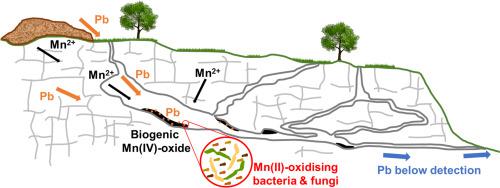Science of the Total Environment ( IF 8.2 ) Pub Date : 2020-09-21 , DOI: 10.1016/j.scitotenv.2020.142312 Laura Newsome , Charles G.D. Bacon , Hokyung Song , Yunyao Luo , David M. Sherman , Jonathan R. Lloyd

|
Lead is a toxic environmental contaminant associated with current and historic mine sites. Here we studied the natural attenuation of Pb in a limestone cave system that receives drainage from the ancient Priddy Mineries, UK. Extensive deposits of manganese oxides were observed to be forming on the cave walls and as coatings in the stream beds. Analysis of these deposits identified them as birnessite (δ-MnO2), with some extremely high concentrations of sorbed Pb (up to 56 wt%) also present. We hypothesised that these cave crusts were actively being formed by microbial Mn(II)-oxidation, and to investigate this the microbial communities were characterised by DNA sequencing, enrichment and isolation experiments. The birnessite deposits contained abundant and diverse prokaryotes and fungi, with ~5% of prokaryotes and ~ 10% of fungi closely related to known heterotrophic Mn(II)-oxidisers. A substantial proportion (up to 17%) of prokaryote sequences were assigned to groups known as autotrophic ammonia and nitrite oxidisers, suggesting that nitrogen cycling may play an important role in contributing energy and carbon to the cave crust microbial communities and consequently the formation of Mn(IV)-oxides and Pb attenuation. Enrichment and isolation experiments showed that the birnessite deposits contained Mn(II)-oxidising microorganisms, and two isolates (Streptomyces sp. and Phyllobacterium sp.) could oxidise Mn(II) in the presence of 0.1 mM Pb. Supplying the enrichment cultures with acetate as a source of energy and carbon stimulated Mn(II)-oxidation, but excess organics in the form of glucose generated aqueous Mn(II), likely via microbial Mn(IV)-reduction. In this karst cave, microbial Mn(II)-oxidation contributes to the active sequestration and natural attenuation of Pb from contaminated waters, and therefore may be considered a natural analogue for the design of wastewater remediation systems and for understanding the geochemical controls on karst groundwater quality, a resource relied upon by billions of people across the globe.
中文翻译:

岩溶含水层中微生物氧化锰对铅的自然衰减
铅是与当前和历史悠久的矿山场所相关的有毒环境污染物。在这里,我们研究了从古老的Priddy Mineries,英国接收排水的石灰岩洞穴系统中Pb的自然衰减。观察到大量的氧化锰沉积物在洞穴壁上形成,并在流化床中形成涂层。这些沉积物的分析鉴定了其中的水钠锰矿(δ-的MnO 2),还存在一些极高浓度的吸附Pb(最高56 wt%)。我们假设这些洞穴结壳是由微生物Mn(II)氧化积极形成的,并且为了对此进行研究,通过DNA测序,富集和分离实验对微生物群落进行了表征。水钠锰矿沉积物中含有丰富多样的原核生物和真菌,其中约5%的原核生物和约10%的真菌与已知的异养型Mn(II)-氧化剂密切相关。大部分原核生物序列(高达17%)被分配到称为自养氨和亚硝酸盐氧化剂的组中,这表明氮循环可能在为洞穴地壳微生物群落贡献能量和碳并因此形成Mn中起重要作用。 (IV)-氧化物和Pb衰减。链霉菌属 和Phyllobacterium属)可以在0.1mM的铅的存在氧化锰(II)。用乙酸盐作为能量来源和碳提供的富集培养物会刺激Mn(II)氧化,但是葡萄糖形式的过量有机物可能会通过微生物Mn(IV)还原生成Mn(II)水溶液。在这个喀斯特溶洞中,微生物Mn(II)的氧化有助于从污染水中螯合和铅的自然吸收,因此可以被认为是废水修复系统设计和理解喀斯特地下水的地球化学控制的天然类似物。质量,这是全球数十亿人赖以生存的资源。











































 京公网安备 11010802027423号
京公网安备 11010802027423号